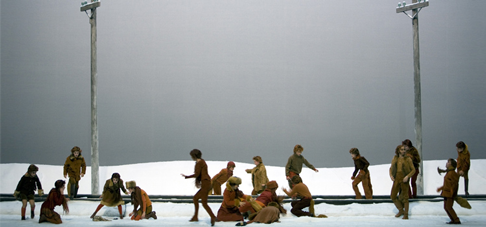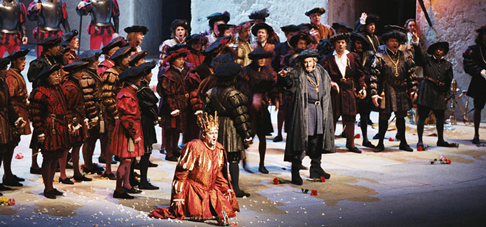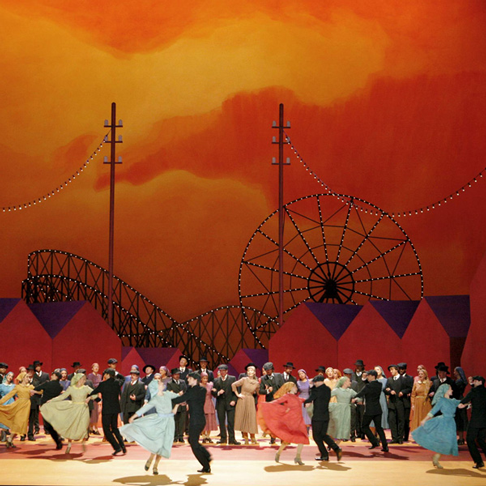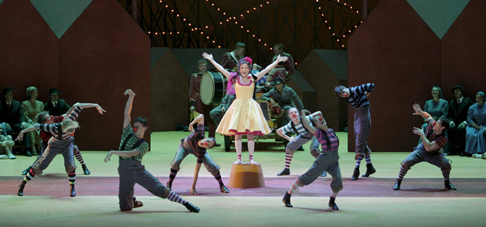From the delicate solo work, to the numerous chamber music moments, to the whole large ensemble in full cry, the orchestra turned in a revelatory reading under Maestro Davies’ sure hand.
That said, balance with the stage was problematic at times. But then, the Bastille can be a problematic house, acoustically. Surely, the openness of the set (more to come on that) with few reflective surfaces did not help the lighter voices project.
Elena Tsallagova certainly has the physique du role for the titular fox. She is petite, sexy, energetic and agile, and threw herself into the action with commendable results. While she can pour out ample silvery top notes that easily ride the orchestra, Ms. Tsallagova’s early scenes found her lower voice covered at times by the orchestra. Thanks to the surtitles, we found ourselves initially reading her performance more than hearing it. Still, from the courtship duet on, she was perfection and the audience rewarded her with a resounding ovation.
Hannah Esther Minutillo proved an exciting match as her foxy suitor. Tall and lean, “he” affected a gangly presence, and deployed an essentially lyric voice with just the right hint of steel to command the scene (and win the girl). Her evenly produced mezzo and fine control of arching line brought a lovely Mozartean sensibility to this key role.
“The Forester” was well-taken by Jukka Rasilainen and his final scene was solidly presented, with his substantial baritone filling the house. The tone is a little straight to my taste, and maybe that is why I didn’t wholly warm to his interpretation. I could have done with less surface presentational technique and far more compassion. In the small role as his “Wife” veteran Michele Lagrange (doubled as “The Owl”) provided secure vocalization, and as “The Hen,” Natacha Constantin did all that was required (if no more).
The men had more vocal opportunities to shine, and generally they made the most of them. Paul Gay offered a decisive take on the poacher “Harasta,” Roland Bracht impressed with his dark bass “Priest,” and best of all, David Kuebler made a secure-voiced, pitiable “Schoolmaster.” As for the rest of the soloists, they have so little to sing that it is difficult (although not impossible) to make much of an impression. I did prefer the few that were usually audible (“Mosquito,” “Dog”) to the many who who simply weren’t. A couple of the children were especially cruelly swamped. Overall, this was wildly uneven vocal casting for a company of this stature.

The production too had its problems starting with the omnipresence of a railroad track running from left wing to right wing (I guess, vice versa, too, huh?). It was backed by a few stylized hills filled with fanciful sunflowers. The kids-dressed-as-forest-creatures appeared from among these yellow fields, from a trap door down left, and simply from offstage.
The act curtain was a joyous design with cartoon characters evocative of the comics upon which the opera is based. I wish it had been somewhat better lit, but it was charming. It rose to reveal a “snail” poking along the track, soon to be joined by a frog, a deer, a caterpillar flying a blue kite (nice image but over-used), and…well, you get the idea. The kids were cute enough, but by the time the hunter comes in and falls asleep (perchance to dream) right on the tracks, you have to start being truly distracted by what this railroad bit might actually “mean.”
Things get no clearer as the “Forester’s” house is revealed to be a dead-end railroad building on some siding or another, complete with a sort of freight loading platform and security wall. The “Dog” (decently played by Letitia Sigleton) is housed in a leftover cement culvert. The scene with the chickens (here a deliciously frowzy and blowzy lot of worn-out floozies) is almost fail-safe, but it never quite takes off.
And by this point I was beginning to understand why. For all of the professionally crafted sets (Nicky Rieti) and witty costumes (Elizabeth Neumuller), director Andre Engel has come up with perfectly acceptable movement and physical business, but has completely missed the tale’s heart. The emotional connection of “Forester” and his vexing-but-beloved “Vixen” is just not there. The tenderness in the courtship scene is in the orchestra, and in the vocal technique of the two star “Foxes,” but it is only touched upon in the staging. The shooting of the “Vixen” that usually shocks an audience into breathless sorrow, here was so limply staged as a hide and seek on the exposed railroad tracks (like, just where was the creature going to “hide”?) that the killing was almost inevitable instead of being the startling surprise it should be. By the time the “Forester” came back on for his moving scena, we had moved on ahead of him. As the oh-so-cute-”animals” came back to the tracks yet again, something evil deep inside me wished that French Rail would come barreling across the stage and send the little critters scampering. Now there would be a fresh and startling surprise!
As it is, there have been far more convincing Vixen productions done with far less, witness the total charm of the well-sung, heartfelt production at Chautauqua last summer. Oh, sure there were some beautiful pictures here in Paris, such as the juxtaposition of imagery as the field of sunflowers is being lit by the full moon and later, the desolation of snow-covered barren tracks. And there was one very funny moment when the “Vixen” runs off stage right in the middle of the Great Chicken Slaughter, and a huge burst of feathers bursts forth (which we were however then stuck with for the rest of the act), but these were in short supply.
Perhaps the rather “small” story of The Cunning Little Vixen would have fared better in the more intimate Palais Garnier, with its superior acoustics. As it is, even with two star performances from The Little Foxes, at the end of the day the production on stage was out-foxed by the superior effort from the pit.
Things were on much surer footing the next night with a winning Rigoletto. For those who relish a “traditional” production, Michel Lebois’s set design delivers the goods, especially as peopled by performers clad in the deliciously rich period court costumes devised by Jacques Schmidt and Emmanuel Peduzzi.
If Mantua had a “Baths of Caracalla,” it would look like this. A massive cracked-and-crumbling stone walled structure evoked a morally decaying society, ancient Italy, and plot-specific places all at once, thanks to a massive, clever “unit” which made good use of the turntable. The wonderfully detailed and textured stonework, and the atmospheric frescoes provided the perfect playing atmosphere for Verdi’s (and Hugo’s) dark tale. Adding to the dramatic focus was the well-judged area lighting by Alain Poisson, although lighting designers everywhere should remember that the rather bright lights of the pit can too easily trump too subtle on-stage nighttime lighting effects. The marauding courtiers in Act One were barely visible, while the brass section was in high relief. But, I digress…

Some excellent scenic moments: Two serving maids make a bed revealed through a curtained upstage arch, preparing it for the Duke’s rape of Gilda, carried in blindfolded and placed upon it like a sacrificial animal. That the Duke’s immorality is so basely sanctioned, heightens (or rather lowers) the deprivation of the court even further. The upper level of the inn allows for good variety in the quartet, and indeed all of Act Four. The courtyard chez “Rigoletto” was a wonderful open playing space, with the requisite staircase to a level above, and a secondary gate to what must be a boat landing below, used for the Duke’s escape. Having three abductors on lantern signal, shimmying down ropes, Zorro-like, from a tower high above was a chilling and terrific effect.
Musically, things could hardly have been bettered. Conductor Daniel Oren led a taut, zippy reading, never once languishing in bathos, although he sensibly indulged “Caro Nome” with expansive phrasing. Within Maestro Oren’s fiery dramatic interpretation, soloists were nevertheless conscientiously accommodated, and musical effects were perfectly judged, witness the breathtaking accelerando which tumbled inevitably to the crackling final chords of Act Two. I had never heard “Corteggiani” seethe and spark like this, and throughout, the myriad orchestral detail on display made me revel in Rigoletto as if it were my first hearing. And…Paris opera assembled as fine a cast as can likely be found today.
Ekaterina Syurina is arguably the finest “Gilda” of my experience. Not only does she boast a full-bodied lyric top that rides the large orchestral climaxes with ease, but she is also capable of spinning sweet filigrees of floated pianissimi replete with well-calibrated ornamentations. Listen to her hold a high note, swell it from a mezzo forte to forte, and then back down to piano with no evidence of changing gears, and you know you are in the presence of a very special talent. On top of that (or “bottom,” actually) Ms. Syurina has a rich and communicative lower voice not usually found in proponents of this Fach. And, she is a beautiful, petite woman — the kind that any Duke (or Prince or King) might fall for. No wonder Ms. Syurina is in demand at Salzburg, the Met, la Scala, you-name-it. The Parisians roared their approval at her curtain call. (Me, too.)
Stefano Secco’s lyric tenor served the “Duke” well. He, too, boasts a solid technique, and a fine command of “messa di voce.” His committed portrayal was well-framed within his vocal means, with only the final sustained note of “Parmi, veder… “ breaking up a little as he pushed it a little fuller than it wanted to go. Overall, his gleaming sound carried well and was intelligently deployed.
Varduhl Abrahamyan was a visually and aurally effective “Maddalena,” her smokey, responsive mezzo seducing us with ease. Kristinn Sigmundsson scored with a more three-dimensional “Sparafucile” than is the norm, and with a clearly produced and commanding bass.
Ambroggio Maestri in the title role was giving his first performance in the continuing run of this revival. Mr. Maestri has a very beautiful, slightly covered tone (think Milnes hooking the top notes), evenly produced throughout the range, and powerful enough to encompass all of the part’s demands. He spun out line after arching line of Verdian phrasing that could stand as a model of its kind. He certainly had the role in his voice, if not on this occasion, in his body. His aloof acting made even Caballe at her most placid look like Faye in “Mommie, Dearest.” His reaction to discovering his murdered daughter in the body bag was, well, almost non-existent. (“Hmmmmm,what’s this? A body? My daughter? Oops, better concentrate on that high note now … .’aaaaaahh’. . “) But rather than lay this only on Mr. Maestri, dramatic flaccidity was fairly pervasive.
For all its musical glories (and they were fabulous), and for all the beauty of the design concept (ditto), I kept having the feeling I might be seeing an “instant opera” staging at a secondary company, where the soloists were jobbed in and given a few general rehearsals. Alejandro Stadler is credited as remounting Jerome Savary’s original direction.
I’d like to believe it was once more grounded in dramatic truth.
I have never seen such a half-hearted effort between the taunting courtiers and “Rigoletto” in the run up to “Corteggiani,” with no visual tension whatsoever. Duet pairings seemed to find participants coming together, separating, pacing individually, and then repeating that formula with too little regard to specific dramatic motivation. Too often soloists planted their feet, faced front and sang, with scant reference to the person they were “conversing” with. One major exception was the “Caro Nome.” I could be wrong, but I suspect the radiant Ms. Syurina brought her experience in the role to bear, and here was a fully motivated, beautifully realized staging, full of dramatic meaning and appropriate movement. As she spun girlishly in a circle like Julie Andrews in “The Sound of Music” while tossing off spot-on staccato octave leaps, well, here was a staging moment that came alive with invention.
These gripes aside, we were nevertheless treated to a world-class Rigoletto as well-sung and -played as is available on today’s world stages, and it was showcased in a truly gorgeous design of the type we hardly ever see anymore. I would only urge the company to re-charge the dramatic batteries to elevate this proceeding from the “highly enjoyable” to the “unforgettable.”
The Bartered Bride’s spunky overture under Jirí Belohlávek promised much, with the orchestra in fine form and all the busy noodling very cleanly done. The painted act curtain featured a stylized road winding in perspective to a distant village, all in vibrant reds and yellows and oranges. When the curtain rose, it revealed the same, up close and personal stylized village houses (boxes with roofs, really, devoid of detail) with a carnival roller coaster and ferris wheel set up behind them, trimmed with rope lights.

Little did we know at the outset that this handsome design by William Orlandi was to be our unit set for the whole show. Oh sure, there were some orange banquet tables added, with yellow straight back chairs, a realistic roadster or two drove on and backed off, and a ringmaster’s round platform got installed, but the look of the show did not change. Mr. Orlandi’s period costumes were functional though devoid of any charming folk influences that might have made for a cheerier presentation. Poor “Mařenka” was especially plain in her upscale off-white house dress that was subtly variegated with pale blue.
Christiane Oelze made a decent vocal impression in the title role. Although her soft-grained voice did not possess much heft in the lower stretches, the many high arching lines gave much pleasure, infused as they were with pristine clarity. However, the role does not seem a wholly congenial match for her. She is a handsome woman who looks just a bit too mature, and I felt that she doesn’t have the touch of metal in her sound that could make “Mařenka” a good sparring partner for the ringing “Jeník” from Ales Briscein.
Mr. Briscein looks young, blond, and chipmunk-cheeked, and was handsomely got up as Billy-Bigelow-as-a-Young-Man. His bronze-hued, pointed lyric tenor delivered all the goods and then some in a part that has been the provenance of such luminaries as Gedda and Wunderlich. He had been announced as being physically limited by an accident, but it was not evident in his stage presence or movement, and certainly not at all in his wonderful vocal production.
We were not so lucky with our “Vašek” as assumed by Christoph Homberger, who was quite light of voice for the part. Both he and Madame Oelze were out-parted in their duet when the orchestration thickened. Too, our tenor was got up as a moussed blonde Baby Huey in a cream Buster Brown suit, and appeared with a green helium balloon, and sucking his thumb. Hmmmm…maybe this idea sounded funnier than it played, cause even for a public that loves Jerry Lewis, there weren’t no laughin’ goin’ down.
“Reliable” is as good word as any to describe Franz Hawlata’s “Kecal.” There were no surprises since, as usual, I found the voice wanting at the very top and a little short on the very bottom, with the rest in between having good ping, savvy comic delivery, and winning, animated stage presence. I keep getting the feeling, though, that his is a competent vocal instrument that has somehow ended up in a major career. “Reliable” is a good quality, I suppose, so …?
Stefan Kocan contributed a burnished bass-baritone and tasteful phrasing as “Mícha,” Oleg Bryjak’s “Krušina” was solid, and Pippa Longworth’s “Ludmila” had a plummy top voice but a less present bottom. Venerable comprimario Heinz Zednick went through some well-studied motions as the “Ringmaster” but lacked spontaneity (man, did he sleepwalk through the curtain call — “this finished yet?”). But perky soprano Amanda Squitieri and talented young bass Ugo Rabec livened up their scenes as “Esmerelda” and “The Indian.” Helene Schneiderman’s well-schooled mezzo had every note in place for an excellent take on “Háta.”
I quite liked much of Micha van Hoecke’s folk based choreography which was filled with spirit and imagination. But the talented corps de ballet struggled as red-nosed, moppety clowns in the circus scene, where the styles of Bob Fosse and Twyla Tharp collided with disappointing results.
Gilbert Deflo’s stage direction left something to be desired. Like, well…stage direction! There is a lot to be said (and I frequently say it) for unfussy, well-motivated blocking that reveals the characters. Here, I found only the “unfussy” part to be true, with inspiration lacking, and relationships only generalized in their outward expression.

The well-schooled chorus (director, Winfried Maczewski) contributed mightily to the musical proceedings, although the ensemble between stage and pit was a bit dodgy in the opening. In fact, although Maestro Belohlávek clearly knows this piece thoroughly, and was mouthing every single word along with the singers, there were several instances over the course of the afternoon where things got slightly (but only slightly) out of sync.
Truth to tell, there was a glorious sunny fall day outside the matinee doors, and it would have taken a fully-committed Bartered Bride to make me glad to be cooped up. Midway in Act II, I found my attention wandering to admire the gilt proscenium arch. By the middle of Act III, as I was reduced to assessing the relative attractiveness of various pit musicians, I knew that this “marriage arrangement” was on the rocks.
James Sohre
![Scene from <em>The Cunning Little Vixen</em> [Photo courtesy of l’Opéra national de Paris]](http://www.operatoday.com/Cunning_Paris1.png)



